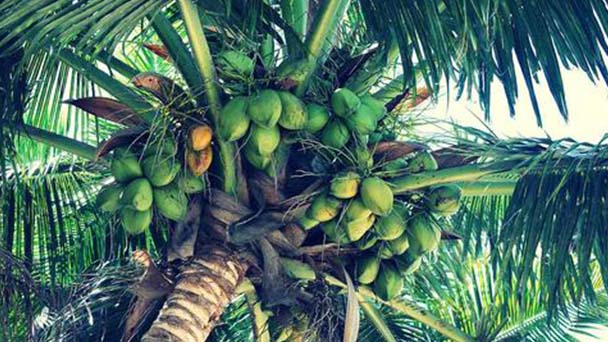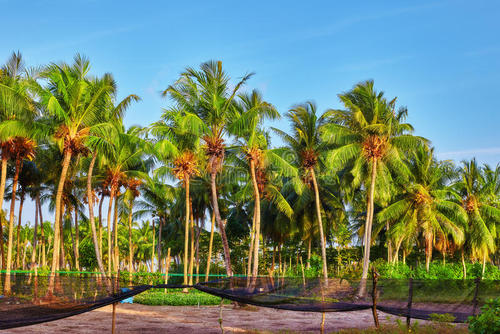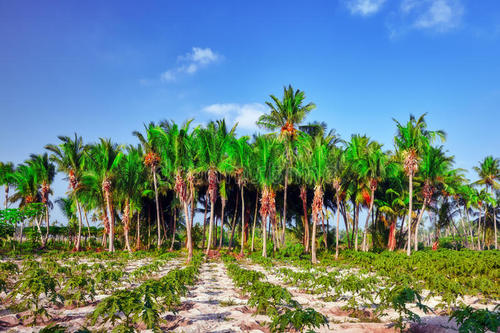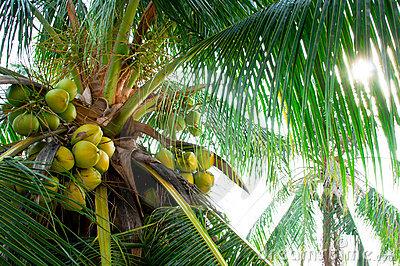How to propagate Cocos Nucifera
Written by Maggie
Dec 24 2020

The coconuts that we eat are the fruit of Cocos nucifera, the only large plant of the palm genus Copra.How to propagate Cocos nucifera? The following we will introduce to you the propagation methods of Cocos Nucifera.

Seed propagation of Cocos Nucifera
Fully ripe coconuts, given the right temperature and humidity, begin to sprout in just over two months. In Hainan, people generally adopt the preparatory nursery to accelerate the bud method. Select a semi-shaded, ventilated, well-drained environment, weed root removal, tillage depth of 15 ~ 20 cm, ditch, the width is slightly wider than the fruit, the planting fruit one by one at an Angle of 45° at the bottom of the trench, buried in the soil to half to two-thirds of the fruit. When the bud is 10 to 15 cm long, move the bud to a moderately shaded nursery and plant coconut, paying attention to watering, draining, weeding and fertilizing. Generally a year or so, about 1 meter high seedlings can be out of the nursery.
Embryo propagation of Cocos Nucifera
Hainan coconut embryo culture test tube seedlings as transplanting test materials. The results showed that the key to the survival of coconut embryo culture seedlings was the quality of embryo culture seedlings, and the survival rate of coconut embryo culture seedlings with developed roots and strong growth was high. The transplant survival rates of normal seedlings, seedlings with few roots and contaminated seedlings were 86.7%, 29.5% and 36.4%, respectively.
The ideal transplanting substrate is peat: coconut bran: river sand =2:1:1; The best transplanting effect is in the environment of the culture chamber.

Cocos Nucifera management measures
After planting, strengthen the management of protecting and repairing seedlings, give proper shade at the early stage of planting, irrigate and keep wet, and replant the missing plants in time.
Tillage, earthing up and intercropping should be cultivated twice a year, that is, one time should be cultivated in Combination with fertilization from November to December, and another time should be cultivated in August to September. As the plant grows, a large number of air roots grow out of the stems of the trunk to carry out soil cultivation and strengthen the tree.
Coconut gardens can be intercropped for short-term crops, such as peanuts, beans, etc. Play the role of live cover and improve the garden humidity, conducive to the growth of young trees.
Cocos nucifera need fertilizer, potash fertilizer is the most, followed by nitrogen, phosphorus and chlorine fertilizer, but must pay attention to the balance of fertilization. When the coconut palms are short of potassium, the stems are thin and the leaves are short, the leaves in the middle of the crown first wither, the upper leaves extend downward, the lower leaves dry and hang down on the trunk. In the absence of nitrogen, young leaves lost their greenness and luster, and old leaves aged to different degrees, and their yields decreased. Lack of phosphorus will cause root development and overrot; The lack of chlorine affects coconut fruit size, nitrogen uptake and water use by the plant. Accordingly, we should give priority to organic fertilizer when fertilizing, fertilizer is auxiliary and apply a few salt. It can be fertilized in April ~ May and November ~ December every year, and the fertilization ditch should be opened 1.5 ~ 2 meters away from the base of the tree, the effect is better.
If we use broadcasting methods, there should be a comprehensive weeding loose soil before fertilization.

Pest control in Cocos Nucifera culture
Common diseases of Cocos nucifera include haemorrhage disease, rhinoceros beetle with two tumors, red palm weevil, coconut pitysophila, red pulse ear borer, etc. Diarrhea is a common disease of Cocos nucifera, which harms the trunk. After onset, the trunk longitudinal crack, outflow of reddish - brown or rust - colored liquid. The diseased tissue is usually removed and then tarred with bordeaux mixture.
The symptoms of Rhinoceros beetles are that the adults drill into the top tip of coconut trees to feed on the unopening heart leaves. In severe cases, the whole plant may die. Control method: Use dichlorvos spray when pests occur. The manifestations of pitysophila were female adults and nymphes attached to the back of coconut tree leaves or on the fruit to suck the SAP, and the damaged leaves were yellow and discolored with irregular green spots on the front. In serious cases, the whole leaf turned yellow, and the injured fruit was stunted.7 to 12 generations a year. Newly hatched nymphs climb to new leaves or fruit, then fixed on the back of the leaves or fruit suction harm. Prevention and cure method: spray imide thiophosphorus, dibromo phosphorus, dichlorvos, phoxim, phoxiphoxide, stone-sulfur mixture, cyanovaleric spray when occurring. The border showed that the larvae harmed Cocos nucifera's flower ears and young fruit, making them fall fruit. Ten generations a year, female adults lay eggs on the male flowers of coconut trees, and feed on the larvae when they hatch. Later, most of the larvae fall with the male flowers, and if they fall on the female flowers or young fruits, they are damaged by moths. This insect mainly harmed young fruit before and after flowering of Cocos nucifera, but rarely harmed young fruit after flowering. Control method: spray trichlorfon or pyrethroid before and after flowering.

Latest Updated
- Benefits of Bugleweed - 7 Science-backed Health Benefits
- Bugleweed Dangers & Side Effects - Is It Poisonous?
- How to Plant Evergreen Trees - What You Should Know
- When to Plant Evergreens - Grow Guide for Evergreen Trees
- 12 Wonderful Evergreen Shrubs for Your Garden
- 12 Popular Evergreen Plants with Pictures for Beginners
- When And How To Prune A Lilac Bush Like a Pro
- How to Grow & Care for Lilac Vine (Hardenbergia Violacea)
- Japanese Lilac Tree (Syringa Reticulata) Care & Propagation Guide
- Shumard Oak Pros and Cons - What to Know
Popular Articles
- Winter maintenance of Antirrhinum Majus
- How to Grow Terminalia Mantaly Tree
- How to Grow and Care for Crossostephium Chinense
- How to grow Antirrhinum Majus in spring
- Peristeria Elata (Dove Orchid) Profile: Info & Care Guide
- Underwatered Snake Plant (Sansevieria Trifasciata) - Signs And How To Fix
- How to Care for Brazilian Jasmine Plant (Mandevilla Sanderi)
- How to Grow & Care for Graptopetalum Purple Delight in Summer
- Rosa Chinensis (China Rose): Plant Growing & Care Tips
- How to Care for Baby Sun Rose (Aptenia Cordifolia)